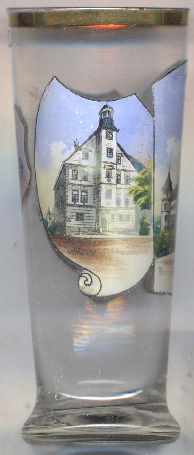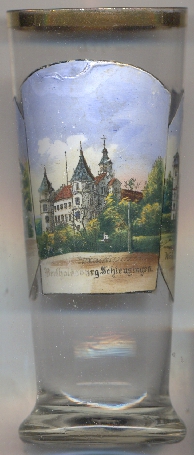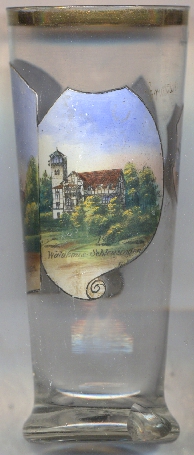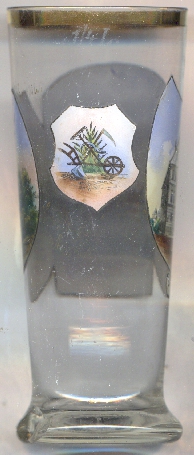

|
| DEUTSCHLAND | GERMANY |
| Bundesland: Freistaat Thüringen | Thuringia |
| Landkreis: Hildburghausen |
Schleusingen is situated at an elevation of 372 m on the river Nahe where thir river meets the river Schleuse. Besides the core town, the municipality also includes the villages of Altendambach, Breitenbach, Erlau, Fischbach, Geisenhöhn, Gethles, Gottfriedsberg, Heckengereuth, Hirschbach, Hinternah, Oberrod, Rappelsdorf, Ratscher, Schleusingerneundorf, Silbach, Sankt Kilian and Waldau. The municipality has a population of about 10,700 (2021).
Villa Slusungen was first mentioned in documents in 1232. As a residence, the Bertholdsburg was built by count Poppy VII of Henneberg from 1226 to 1232. The county of Henneberg was partitioned into three lines in 1274 and Schleusingen thus became theresidence of the counts of Henneberg-Schleusingen. In 1412 it obtained the privileges of a town, but only in 1533 those of holding markets. The Reformation was introduced here in 1544. When in 1583 the last count of Henneberg died without male heir, Schleusingen was inherited by the Saxon dukes of the Ernestine and Albertine lines, at first under joint administration. In the Saxon Partition Agreement of 1660, the city and district of Schleusingen fell to Saxony-Zeitz. and in 1718 was inherited by the Albertine line of the Wettin dynasty, the Dukes and Electors of Saxony. From 1815 Schleusingen belonged to Prussia and in 1816 became the administrative centre of a district. The railway line from Schleusingen to Themar opened in 1886, followed by the lines to Ilmenau in 1904 and to Suhl in 1911. Towards the end of the 19th century, Schleusingen became known as a resort town. Afther World War II, the district of Schleusingen became part of Thuringia and in 1946 was renamed district Suhl. For abrief period, from 1950 to 1952, it was re-allocated to the district Hildburghausen before reverting to the district Suhl. The latter was finally merged into the district Hildburghausen in 1994.




 Castle Bertholdsburg [left, no. 4317: middle picture]
was built from 1226 to 1232 by count Poppo VII of Henneberg. After the Henneberg lands had been divided into three lines in 1274, the castle became
the seat of the counts of Henneberg-Schleusingen. The complex got its current Renaissance appearance around 1500. In 1583 the Hennebergers died out
and the area around the towns of Schleusingen and Suhl fell to Electoral Saxony and in 1657 to Saxony-Zeitz. Since the County of Henneberg formally
continued to exist until then, the Bertholdsburg and Schleusingen represent the last Frankish residence in today's Thuringia. They continued to be
administered from the Bertholdsburg, where the Saxon supervisory office was located until 1815/16. As a result of the Cogress of Vienna
(1815) Schleusingen passed to Prussia, which created the Schleusingen district. the district existed until 1952 and was administered from Bertholdsburg
until 1929, before the district seat was moved to Suhl. Since 1934 the castle is used as a museum.
Castle Bertholdsburg [left, no. 4317: middle picture]
was built from 1226 to 1232 by count Poppo VII of Henneberg. After the Henneberg lands had been divided into three lines in 1274, the castle became
the seat of the counts of Henneberg-Schleusingen. The complex got its current Renaissance appearance around 1500. In 1583 the Hennebergers died out
and the area around the towns of Schleusingen and Suhl fell to Electoral Saxony and in 1657 to Saxony-Zeitz. Since the County of Henneberg formally
continued to exist until then, the Bertholdsburg and Schleusingen represent the last Frankish residence in today's Thuringia. They continued to be
administered from the Bertholdsburg, where the Saxon supervisory office was located until 1815/16. As a result of the Cogress of Vienna
(1815) Schleusingen passed to Prussia, which created the Schleusingen district. the district existed until 1952 and was administered from Bertholdsburg
until 1929, before the district seat was moved to Suhl. Since 1934 the castle is used as a museum.
The building the later became the  town hall [left picture] in 1583 was chosen as a dowager seat of
the countess Elisabethm, the widow of count Georg Ernst, the last count of Henneberg-Schleusingen. In 1586 she sold the house to the town and at the same time she
increased the purchase price of 1,500 guilders to 2,000 guilders and donated the sum to the town's poor. As a token of gratitude, the town erected a
statue of the countess on the market fountain. The town hall today is preserved in the post-Gothic secular style of the 17th century.
town hall [left picture] in 1583 was chosen as a dowager seat of
the countess Elisabethm, the widow of count Georg Ernst, the last count of Henneberg-Schleusingen. In 1586 she sold the house to the town and at the same time she
increased the purchase price of 1,500 guilders to 2,000 guilders and donated the sum to the town's poor. As a token of gratitude, the town erected a
statue of the countess on the market fountain. The town hall today is preserved in the post-Gothic secular style of the 17th century.
The right picture on the glass is labeled as  Waldhaus
Waldhaus
[https://de.wikipedia.org/wiki/Schleusingen, https://en.wikipedia.org/wiki/Schleusingen;
https://de.wikipedia.org/wiki/Schloss_Bertholdsburg;
https://www.schleusingen.de/seite/527746/rathaus.html]
![[scale]](lineal.jpg)